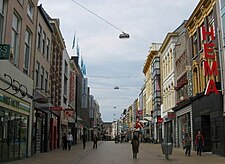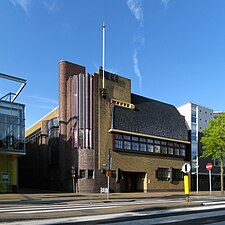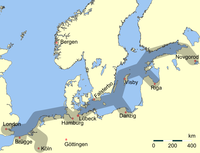| Main | Births etc |
|---|
| Groningen | |||
|---|---|---|---|
| — Municipality / City — | |||
|
|||
| Coordinates: Coordinates: | |||
| Country | Netherlands | ||
| Province | Groningen | ||
| Municipality | Groningen | ||
| Government | |||
| • Mayor | Peter Rehwinkel (PvdA) | ||
| Area(2006) | |||
| • Total | 83.69 km2 (32.31 sq mi) | ||
| • Land | 79.59 km2 (30.73 sq mi) | ||
| • Water | 4.10 km2 (1.58 sq mi) | ||
| Population (1 February 2012) | |||
| • Total | 192,735 | ||
| • Density | 2,469/km2 (6,390/sq mi) | ||
| Source: CBS, Statline. | |||
| Time zone | CET (UTC+1) | ||
| • Summer (DST) | CEST (UTC+2) | ||
| Postal codes | 9711–9747 | ||
| Area code(s) | 050 | ||
Groningen (Dutch pronunciation: [ˈɣroʊ̯.nɪ.ŋə(n)], locally [ˈxroː.nɪ.ŋən] ( listen); Gronings: Grunnen; West Frisian: Grins) is the main municipality as well as the capital city of the eponymous province in the Netherlands.
With a population of around 190,000, it is the largest city in the north of the Netherlands. Groningen is a university city, inhabited on average by about 37,000 students.
History[]

Map of Groningen, 1925.

Boroughs of Groningen

Groninger Museum (2004)

Main building of the University of Groningen (2004)

The Martini Tower

The Aa Church (2004)

The Aa Church by night (2009)

'De Heerestraat', the main shopping street (2004)

Groningen has many Amsterdam School architecture buildings

View of the city hall from the Martini Tower
The city was founded on the northernmost point of the Hondsrug area. The oldest document referring to Groningen's existence dates from 1040. However, the city already existed long before then: the oldest archaeological traces found are believed to stem from the years 3950-3720 BC, although the first major settlement in Groningen has been traced back to the 3rd century AD.
In the 13th century, when Groningen was an important trade centre, its inhabitants built a city wall to underline its authority. The city had a strong influence on the surrounding lands and made its dialect a common tongue. The most influential period of the city was the end of the 15th century, when the nearby province of Friesland was administered from Groningen. During these years, the Martinitoren was built, which loomed over the city at (then) 127 metres tall, making it the highest building in Europe at the time. The city's independence came to an end when it chose to join forces with the Spanish during the Eighty Years' War in 1594. It later switched sides, joining the Republic of the Seven United Netherlands.
In 1614, the University of Groningen was founded, initially only for religious education. In the same period the city expanded rapidly and a new city wall was built. That same city wall was tested during the Third Anglo-Dutch War in 1672, when the city was attacked fiercely by the bishop of Münster, Bernhard von Galen. The city walls resisted, an event which is celebrated with music and fireworks on 28 August (as "Groningens Ontzet" or "Bommen Berend").
The city did not escape the devastation of World War II. In particular, the main square, Grote Markt, was largely destroyed in April 1945, at the Battle of Groningen. However, the Martinitoren, its church, the Goudkantoor, and the city hall were not damaged. The battle there lasted several days.
University of Groningen[]
The University of Groningen (in Dutch: Rijksuniversiteit Groningen) has a rich academic tradition which dates back to 1614. After the University of Leiden, it is the oldest university located in the Netherlands. The university educated the first female student and the first Dutch national astronaut in the history of the country, the first president of the European Central Bank and a Nobel prize winner. They share their academic roots with around 200,000 people, who were either students, teachers or researchers at the university. Groningen has the highest percentage of students by total population, approximately 25 percent.
Art, culture and nightlife[]
The city is nationally known as the "Metropolis of the North" and as "Martinistad" referring to the Martinitoren.
Although Groningen is not a very large city, it does have an important role as the main urban centre of this part of the country, particularly in the fields of music and other arts, education, and business. The large number of students living in Groningen also contributes to a diverse cultural scene for a city of its size.
Museums[]
The most important and most famous museum in Groningen is the Groninger Museum. With the construction of its current building, designed by Alessandro Mendini, the museum has been transformed into one of the most modern and innovative of its kind in the Netherlands. In addition, the city also has a maritime museum, a university museum, a comics museum, a graphical museum and a tobacco museum. Groningen is also home of Noorderlicht, an international photographic platform that runs a photo gallery and organizes an international photo festival.
Theatre and music[]
Groningen has its own city theatre (Stadsschouwburg), located on the Turfsingel; a big theatre and concert venue called Martini Plaza; and another major cultural venue on the Trompsingel, called the Oosterpoort. Vera is located on the Oosterstraat, Grand Theatre on the Grote Markt, and Simplon on the Boterdiep. Several cafes feature live music, a few of which specialize in jazz music, including Jazzcafe De Spiegel on the Peperstraat. The jazz music students from the Prins Claus Conservatorium have been known to hold regular jam sessions in cafes such as Peter Pan on the Voor Het Voormalige Klein Poortje and café De Smederij on the Tuinstraat 2–4. Groningen is also the host city for the Eurosonic Festival, an annual music showcase event for over a hundred bands from all over Europe.
Nightlife[]
Groningen's nightlife depends largely on its student population. Its cultural scene is vibrant and remarkable for a city of its size. In particular, the Grote Markt, the Vismarkt, and the Poelestraat and Peperstraat are crowded every night of the week, and most bars do not close until 7 in the morning. Between 2005 and 2007, Groningen was elected "de beste binnenstad" (the best city centre) of the Netherlands.[1] There are also two red-light districts, one in Nieuwstad (a street) and one in the A-kwartier (an area). Both of them are in or near the city centre.
International relations[]
Twin towns – Sister cities[]
Groningen is twinned with the following cities:[2]
|
and in addition has a sister city relationship with the American state of Michigan, with the city of Holland, Michigan
Politics[]
The city council has 39 members. The left-wing parties PvdA and GroenLinks are the largest. After the elections in 2002, they formed a coalition with CDA and VVD. Peter Rehwinkel has been the mayor since 2009. As a result of the elections of 2006, three left-wing parties (PvdA, GroenLinks and SP), decided to form a new coalition, which was appointed on 26 April 2006.
Industry[]
Until recently, there were two large sugar factories inside the city boundaries. The factory of the Suiker Unie was originally outside of Groningen, but it was completely swallowed by the expansion of the city. After a campaign to close the factory, it was finally shut down in 2008/2009. Before closing down, the sugar production amounted to 250,000 tonnes of beet sugar, with 250 employees (2005 figures). The only remaining sugar factory is CSM Vierverlaten in Hoogkerk, which produces 235,000 tonnes of beet sugar, with 283 employees.
Other well known companies from Groningen are Hooghoudt (a producer of alcoholic beverages, genever and beerenburg, amongst others), publishing house Wolters-Noordhoff and Theodorus Niemeyer (a coffee, tea and tobacco company).
Topography[]

Topographic map image of Groningen, 2010-2011.
Transport[]
Cycling and walking[]
Groningen has been called the "World Cycling City", since 57% of journeys within the city are made by bicycle.[5] The city is very much adapted to the wishes of those who want to get around without a car, as it has an extensive network of segregated cycle-paths, good public transport, and a large pedestrianised zone in the city centre. The transformation of the historic centre into a pedestrian priority zone enables and invites walking and biking by making these active modes of transport comfortable, safe and enjoyable. These attributes are accomplished by applying the principle of "filtered permeability". It means that the network configuration favours active transportation and selectively, “filters out” the car by reducing the number of streets that run through the centre. While certain streets are discontinuous for cars, they connect to a network of pedestrian and bike paths which permeate the entire centre. In addition, these paths go through public squares and open spaces increasing the enjoyment of the trip (see image). The logic of filtering a mode of transport is fully expressed in a comprehensive model for laying out neighbourhoods and districts – the Fused Grid. In the Italian TV programme of investigative journalism "Report" appeared a short film,[6] considering the use of bikes in Groningen a good practice to emulate in Italy.
Rail[]
There are three stations in Groningen:
- Groningen
- Groningen Europapark
- Groningen Noord
The main train station (served by the Nederlandse Spoorwegen and Arriva) has regular services to most of the major cities in the Netherlands.
Direct destinations are:
- Zwolle, Amersfoort, Hilversum, Amsterdam-south and Schiphol Airport (Nederlandse Spoorwegen)
- Zwolle, Amersfoort, Utrecht, Gouda, The Hague or Rotterdam (Nederlandse Spoorwegen)
- Leeuwarden (Arriva)
- Hoogezand-Sappemeer, Winschoten, Leer (Germany) (Arriva)
- Hoogezand-Sappemeer, Veendam (Arriva)
- Roodeschool and Delfzijl (Arriva)
Road[]
The A28 motorway connects the city of Groningen to Utrecht (via Zwolle and Amersfoort). The A7 motorway connects Groningen to Friesland and Amsterdam (South-West) and Winschoten and the direction of Bremen in the East.
Bus[]
Qbuzz run several city buses and urban buses. The main routes are:
- 3: Lewenborg-city centre-main station-Vinkhuizen
- 6: Beijum-city centre-main station-Hoornsemeer
- 4/8 Hoogkerk-centre-main station
- 11: Zernike-city centre-main station
- 15: Zernike-city centre-main station
- 33/39/133: Groningen-Surhuisterveen
- 50/51: Groningen-Assen
- 61: Groningen-Bedum-Uithuizen
- 82 Groningen-Roden
- 140: Groningen-Appingedam-Delfzijl
- 163: Groningen-Lauwersoog (connecting the ferry to Schiermonnikoog)
- 300/305: Groningen-(Gieten(300))-Borger-Emmen
- 301: Groningen-Veendam
- 304/314: Groningen-Drachten-Heerenveen
- 315: Groningen-Heerenveen-Lemmer-Lelystad (longest bus route in The Netherlands) – Interliner
There are also direct buses between Groningen (train station) and Bremen (airport) in Germany, run by Public Express.
In the near future, there are plans to build a tram route connecting the central station, the city centre and the university complex (Zernike).
Air[]
Groningen Airport Eelde is located 10 km south of the centre of Groningen, with scheduled and holiday charter services to European destinations.
Climate[]
Groningen has a cool temperate climate similar to most of the Netherlands, although somewhat colder in winter than other major cities due to its northeasterly position. Groningen has relatively cool summers and cold winters. Weather is influenced by the North Sea to the north-west and its prevailing north-western winds and gales. Winter temperatures are cool: on average above freezing, although frosts are common during spells of easterly winds blowing in from the inner European continent, i. e. Germany, Russia and even Siberia. Night-time temperatures of −10 °C (14 °F) or lower are not uncommon during cold winter periods. The lowest temperature ever recorded is −26.8 °C (−16.2 °F) on February 16, 1956. Snow often falls, but rarely stays consecutively due to warmer daytime temperatures although white snowy days happen every winter. Summers are somewhat warm and humid. Temperatures of 30 °C (86 °F) or higher occur sporadically, most average daytime high's are around 22 °C (72 °F). Very rainy periods are common, especially in spring and summer. Average annual precipitation is about 900 mm. Sunshine hours vary,but are usually lacking below 1400 hours,creating a grey climate feeling,similar to most of the Netherlands.
| Climate data for Groningen | |||||||||||||
|---|---|---|---|---|---|---|---|---|---|---|---|---|---|
| Month | Jan | Feb | Mar | Apr | May | Jun | Jul | Aug | Sep | Oct | Nov | Dec | Year |
| Average high °C (°F) | 4.4 (39.9) |
5.0 (41.0) |
8.8 (47.8) |
12.4 (54.3) |
17.2 (63.0) |
19.6 (67.3) |
21.6 (70.9) |
22.1 (71.8) |
18.4 (65.1) |
13.7 (56.7) |
8.6 (47.5) |
5.7 (42.3) |
13.13 (55.63) |
| Average low °C (°F) | −1.6 (29.1) |
−1.6 (29.1) |
1.4 (34.5) |
2.9 (37.2) |
6.7 (44.1) |
9.3 (48.7) |
11.5 (52.7) |
11.3 (52.3) |
9.0 (48.2) |
5.8 (42.4) |
2.7 (36.9) |
0.7 (33.3) |
4.8 (40.72) |
| Source: [7] | |||||||||||||
Football stadium[]
The football stadium of FC Groningen is called Euroborg. Opened in January 2006, the stadium has 22,600 seats. There are plans to expand the stadium to a capacity of 35- or 40,000. The former football stadium of FC Groningen is the Oosterpark Stadion (12,500 seats).
Notable people from Groningen[]
- Willem Arnold Alting (1724), Governor-General of the Dutch East Indies from 1780 until 1797
- Joseph Ascher (1829), composer and pianist
- Jacob B. Bakema (1914) modernist architect
- Daniel Bernoulli (1700), mathematician and physicist
- Roche Braziliano (ca. 1635), pirate
- Dirk Jan de Geer (1870), Jonkheer, conservative statesman and Dutch Prime Minister (1926–1929, 1939–1940), disgraced for advocating a peace settlement between the Netherlands and Nazi Germany in 1940
- Volcher Coiter (1534), anatomist, founder of comparative osteology and first to identify cerebrospinal meningitis
- Julia Culp (1880), mezzo-soprano, the "Dutch nightingale"
- Jaap Eden (1873), only male athlete to have won world championships in both speed skating and cycling
- Albert Eckhout (1610), painter
- John Goodricke (1764), astronomer
- Nico Habermann (1932), computer scientist
- Tiberius Hemsterhuis(1685) philologist
- Pete Hoekstra (1953), American Republican member of Congress representing Michigan's 2nd congressional district
- Johan Huizinga (1872), historian
- Jozef Israëls (1824), painter
- Dirk Janssen (1881), gymnast in the 1908 Summer Olympics who at his death at the time of his death 105 in 1986 was the longest-lived Olympic competitor in history
- Gerard Kemkers (1967), speed skating bronze medalist at 1988 Winter Olympics
- Egbert Bartholomeusz Kortenaer (1604), Dutch admiral
- Hendrik Willem Mesdag (1831), painter
- Heike Kamerlingh Onnes (1853), Nobel laureate physicist who pioneered refrigeration techniques and discovered superconductivity
- Etta Palm d'Aelders (1743), early feminist and spy
- Wim T. Schippers (1942), artist, comedian
- Maarten Schmidt (1929), astronomer who named and was the first to optically identify a quasar
- Jan Sloot (ca. 1945), inventor, claimed to have invented a revolutionary data compression technique
- Rutger Smith (1981), track and field athlete competing in shot put and discus throw, the first athlete to win medals at World Championships in both events
- A. W. L. Tjarda van Starkenborgh Stachouwer (1888), Dutch nobleman and last colonial Governor-General of the Netherlands East Indies, now Indonesia
- Jan C. Uiterwijk (1915), entrepreneur and shipping line owner
- Samuel van Houten (1837), politician, cabinet minister and founder of the short lived Liberal Party
- Stephan Veen (1970), two-time Olympic gold medalist in field hockey with the Dutch national squad in the 1996 Summer Olympics and the 2000 Summer Olympics
- Ida Vos (1931), writer and poet
- Corrie Winkel (1944), backstroke swimmer and silver medalist in the 4x100 m medley relay at the 1964 Summer Olympics
See also[]
- Battle of Groningen
- Jewish Groningen
- Siege of Groningen
References[]
- Notes
- ^ "Winnaars 2005 - 2007 -- Verkiezing Beste Binnenstad [Winners 2005 - 2007 -- Election Best City Centre]" (in Dutch). www.debestebinnenstad.nl. http://www.debestebinnenstad.nl/winnaars/winnaars-2005-2007/grote-binnenstad/. Retrieved 15 February 2012.
- ^ "Groningen – Partner Cities". 2008 Gemeente Groningen, Kreupelstraat 1,9712 HW Groningen. http://www.groningen.nl/functies/pagfunctie.cfm?parameter=1285. Retrieved 8 December 2008.
- ^ "Twin Towns – Graz Online – English Version". www.graz.at. http://www.graz.at/cms/beitrag/10045157/606819/. Retrieved 5 January 2010.
- ^ "Kaliningrad – Partner Cities". 2000–2006 Kaliningrad City Hall. http://www.klgd.ru/en/search/index.php?q=partner+cities&where=. Retrieved 8 December 2008.
- ^ "global ideas bank". globalideasbank.org. 15 October 2007. http://www.globalideasbank.org/site/bank/idea.php?ideaId=378. Retrieved 14 July 2009.
- ^ "Rai.tv". Rai.tv. 15 October 2007. http://www.rai.tv/mpplaymedia/0,,RaiTre-Report%5E23%5E37292,00.html. Retrieved 5 May 2009.
- ^ "World Weather Information Service – Amsterdam (Schiphol)". Worldweather.org. 5 October 2006. http://www.worldweather.org/037/c00143f.htm#climate. Retrieved 5 May 2009.
External links[]
| Wikisource has the text of a 1905 New International Encyclopedia article about Groningen. |
- Travelguide to Groningen from Wikitravel
- Bus lines (PDF)
- CSM sugar
- Groningen Official Website
- Groninger Museum
- Publicexpress bus line
- Tourist information
- Map of Groningen
- University of Groningen
- Vera – club for the international pop underground
- Webcam – shows Oude Ebbingestraat
- Second World War History
- Groningen on Google Maps
- 360° Fullscreen panoramas from Groningen
- WM entry
Template:Principal cities of the Netherlands
| ||||||||||||||||||||||||||||||||||||||||||||||
Template:Province Groningen
| |||||||||||
| This page uses content from the English language Wikipedia. The original content was at Groningen. The list of authors can be seen in the page history. As with this Familypedia wiki, the content of Wikipedia is available under the Creative Commons License. |





